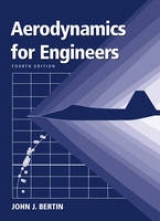
Aerodynamics for Engineers
Prentice Hall (Verlag)
978-0-13-761487-5 (ISBN)
- Titel erscheint in neuer Auflage
- Artikel merken
This comprehensive guide to aerodynamics focuses on practical problems and discusses the fundamental principles and techniques used to solve these problems. It presents a background discussion of each topic followed by a presentation of the theory, and then derives fundamental equations, applies them to simple computational techniques, and compares them to experimental data.* NEW - Places more emphasis on design applications of phenomena/equations. * NEW - Relocates CFD-specific coverage to the beginning of the text (Ch. 3). * NEW - Adds/expands/revises discussions on: * Derivation of the drag polar (Ch. 5). * Sample problems on the calculation of wing geometry parameters for a delta wing and for the Space Shuttle Orbiter (Ch. 5). * Parasite drag (Ch. 5). * Included drag (Ch. 5). * L/D ration (Ch. 5). * The stall velocity for the F-16 (Ch. 5). * High lift military airfoils, including Flow field phenomena and data from recent AIAA papers. (Ch. 6). * Factors affecting drag due to lift at subsonic speeds (Ch. 7). * High angle of attack aerodynamics (Ch. 7).
* The relation between the distribution of the cross-section area and the transonic drag rise, including an interesting case study for the transonic drag rise problems for the B-58, using flight data from NASA Langley, photographs, and quotes from Harry Hillaker (Ch. 9). * Numerical method for calculating the pressure distribution given the configuration (Ch. 11). * Numerical method for the determination of the camber Distribution (Ch. 11). * The design of the SST and of the HSCT (Ch. 11). * High L/P hypersonic configurations - waveriders (Ch. 12). * The evolution of the F-16 (Ch. 13). * Considerations for wing/canard, wing/tail, and tail-less configurations (Ch. 13). * Tables summarizing the main design features for a variety of operational requirements (Ch. 13). * Codes for aircraft design and calibration and validation of codes (Ch. 14). * NEW - Includes more sample problems and homework problems. * Makes use of spread-sheet software available as part of most office packages. * NEW - Cites recent references from the literature. * Presents a background discussion of each topic, followed by a presentation of the theory.
* Carefully notes the assumptions (and, therefore, the restrictions) incorporated into the development of the theory. * Illustrates applications of theory with example problems. * Example problems are worked for relatively simple flow fields which can be adequately defined by a few control points and which can be worked using electronic calculators. * Solutions are obtained using numerical techniques in order to apply the theory for those flows where closed-form solutions are impractical or impossible. * Compares the theoretical solutions and/or the computed results with experimental data from the open literature to illustrate both the validity of the theoretical analysis and its limitations (or, equivalently, the range of conditions for which the theory is applicable). * Uses both SI units and English units throughout. * Includes conversion factors between SI units and English units.
1. Fluid Properties. 2. Fundamentals of Fluid Mechanics. 3. Dynamics of an Incompressible, Inviscid Flow Field 4. Incompressible, Viscous Boundary Layers. 5. Characteristic Parameters for Airfoil and Wing Aerodynamics. 6. Two-Dimensional, Incompressible Flows Around Thin Airfoils. 7. Incompressible Flow About Wings of Finite Span. 8. Dynamics of a Compressible Flow Field. 9. Compressible, Subsonic Flows and Transonic Flows. 10. Two-Dimensional, Supersonic Flows About Thin Airfoils. 11. Supersonic Flows Over Wings and Airplane Configurations. 12. Hypersonic Flows. 13. Aerodynamic Design Considerations. 14. Computational Fluid Dynamics. Appendix A. The Equations of Motion Written in Conservation Form. Appendix B. A Collection of Often Used Tables. Appendix C. Derivation of the Velocity Potential Equation.
| Erscheint lt. Verlag | 7.10.1997 |
|---|---|
| Verlagsort | Upper Saddle River |
| Sprache | englisch |
| Maße | 180 x 235 mm |
| Gewicht | 979 g |
| Themenwelt | Technik ► Maschinenbau |
| ISBN-10 | 0-13-761487-X / 013761487X |
| ISBN-13 | 978-0-13-761487-5 / 9780137614875 |
| Zustand | Neuware |
| Haben Sie eine Frage zum Produkt? |
aus dem Bereich



